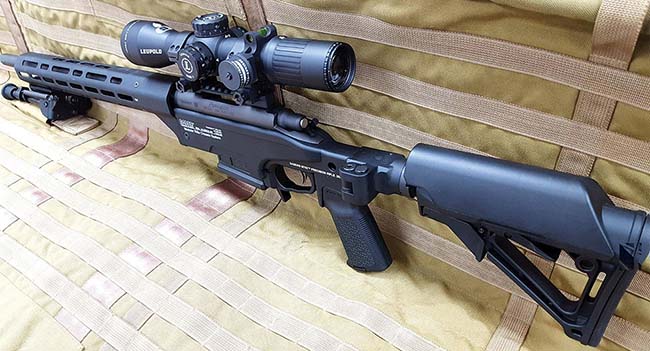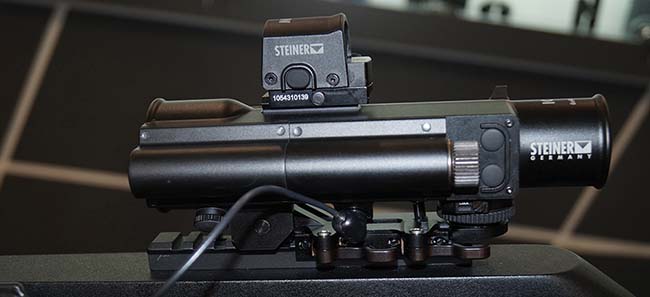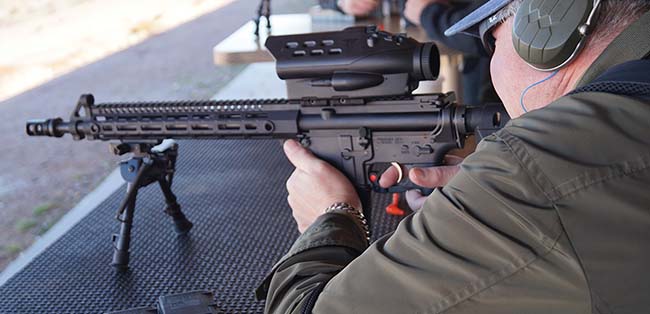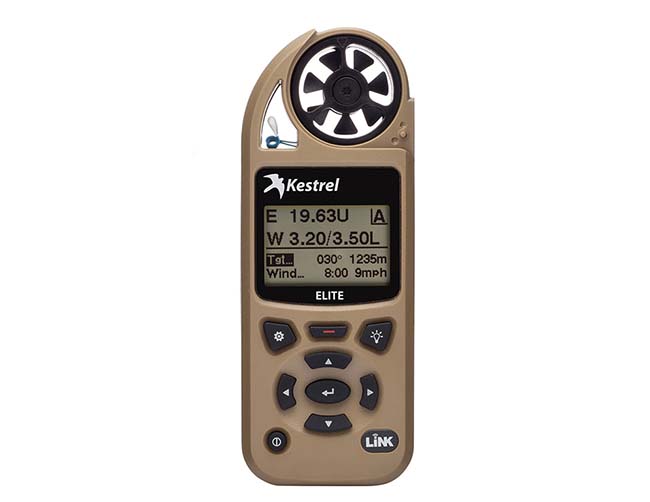As noted, before a scope is integral to a rifle when used by a designated marksman or a sniper. High quality medium-range scopes and long-range scopes are available from many suppliers, like ZEISS, Leupold, Steiner Optics, Hensoldt and Schmidt & Bender, just to mention a few.
One Example of a Long-Range Scope
One scope that tried and tested by the Bundeswehr (German armed forces) is the Schmidt & Bender 3-20×50 PMII with variable magnification from 3x to 20x permits the scope to be used universally on a multitude of rifles with different calibers. Due to its rather comprehensive total adjusting range of 260cm, the scope may even be used at very large distances.
Elevation and windage turrets are equipped with a locking function and a double turn including a second tactile level. This system will prevent the elevation and windage turrets from any inadvertent adjustment. The tactile double turn and the tactile clicks at every 10th click are designed to reduce and prevent operating errors due to stress. On request the reticle may be included in the first or second focal plane. On top of that, the scope features parallax compensation from 25m to infinity.
Together with the scope there are also some sniper tools used like an Angle Cosine Indicator and a Kestrel 5700 Elite meter. These two enhancements are described at the end of the article.
Intelligent Sights
Technology is always in a shape of a phase in modern warfare. For the sniper these technological advances come in an unprecedented speed. What has happened here in the last generation is that computers and satellite technology are used in tandem. These technological advances have increased snipers’ effectiveness and given an advantage against the enemy. Lasers and ballistic computing equipment are making the sniper faster and more lethal; there are Ballistics Calculator applications available for Smart Phones, but the calculated trajectory may differ from the real trajectory at long ranges. The user must assume the entire risk of using the program and data.
Perhaps the most technological revolution has been the development and refinement of night vision devices. For example, in 2016 BERTIN launched the world’s first digital night vision device, night and day vision enhancer combining two viewing modes, based on color low-light and thermal cameras, to use separately or in smart fusion. The next SADJ article (“Precision Rifle Technology Developments—Night Combat Capabilities,” on p. 42) will describe some night vision sights to use in-line with day scopes or clip-ons.
The purpose of this article is to present some intelligent combat sights and range finder devices that are combined with ballistic computing. This new development helps the sniper to decipher the rifle’s exact elevation (range setting) to the target.
For most of the 20th century the technique to determine the target’s distance has been the MIL-Dot relation formula. Reference points inside the scope’s ocular are used together with a complex formula to estimate the distance to the target. That is a skill every sniper must master. To help speed it up, the snipers today have a tool to help them get the accurate range to the target in under a second, a small weapon laser range finder. There are still many variables such as wind speed, temperature and distances that influence the projectile on its way to the target. These complex calculations take months of training before snipers fully understand how to make the scope’s adjustments correctly in the field to enable an accurate shot. Today the sniper can utilize software gadgets to solve these problems in seconds. These ballistic calculators can compute all known variables into what’s called a firing solution. Having the knowledge of the formula/equation and a ballistic calculator makes every sniper a better sniper. Of course, no matter how advanced the sniper equipment becomes, it’s crucial that every sniper master and maintain (MIL-Dot) basic skills because all technology can fail.
Fire Control System
Fire control systems are traditionally associated with much larger platforms such as tanks and infantry fighting vehicles where many components work together to hit a target. Now there are digital fire-control systems, weighing only some few pounds and small enough for assault rifles. Digitization has also reached the optical industry and brings along new challenges. The electronics share of the optics is increasing. Riflescopes are increasingly developed to be an integral part of the respective weapon, and they continue to become smarter through the use of external data in combination with ballistic computers and fire control systems.
Steiner Optics’ portfolio includes the new Intelligent Combat Sight (ICS) which integrates a laser rangefinder and a ballistic calculator into a rugged, compact tactical weapons sight for increased accuracy. That gives greater first-round hit probability and shorter engagement time. At the push of a button, an eye-safe laser instantly provides distance to the target and calculates an illuminated, trajectory-compensated aiming point based on ammunition ballistics, measured distance and angle to the target out to 800m. A Red Dot indicates precise point of aim for specific cartridge and distance.
As a true electro-optical aiming device, it combines combat-optimized technology, operating simplicity in the field and the targeting effectiveness to give small-caliber weapons oversized clout. ICS is rugged, intuitive and easy to use. Its weight is 790g. It accepts cartridge ballistic data for ammunition-specific targeting and can be easily set up for 5.56mm, 7.62mm, .300 Blackout and .300 Win Mag cartridges. ICS has fixed 6x magnifications for targeting at longer ranges. The illuminated reticle adjusts from dim to bright for daylight conditions. ICS is fully adjustable for windage and up to 120 MOA of elevation. For quick fingertip laser activation there is a cable pressure pad. The ICS provides trajectory compensation by automatically calculating the point of aim based on ammunition ballistics, measured distance and angle to the target out to 800m.The Picatinny base on top is for mounting an auxiliary sight for CQB operation.

The Mepro Meslas by Meprolight is a sniper’s 10×40 sniper rifle scope and fire-control computer with a built-in laser rangefinder. The laser is operating in an eye-safe spectral range (invisible to night vision devices) and is effective to 2,000m. Mepro Meslas is also fully programmable by the sniper who can upload specific ballistics tables, wind tables and other information in accordance with the type of rifle and ammunition. When measuring distance the Mepro Meslas automatically calculates the ranged target and displays the correct aiming point in the scope’s field of view with automatic elevation correction. The Mepro Meslas has a communication port for remote operation and ballistic data update. The Mepro Meslas is a robust system, withstanding shock, vibration and extreme environmental conditions. It weighs 4.05 pounds. It has optional wind, elevation, humidity and axial sensors for further compensations. But this sensor package takes only the atmospheric data from the position of the shooter, so it does not replace the importance of the spotter.
TrackingPoint makes a rifle for a Precision-Guided Firearm system. The tracking optic uses computer vision and the same tracking and fire-control capabilities found in advanced fighter jets. This author tried the system in January 2017. It gives the shooter a very high first-round hit probability. The optic and the guided trigger collaborate to precisely release the shot within 0.5 inch of the designated aim point at 0.57 miles. For comparison, elite marksmen release shots within 4 inches of an aim point at 0.57 mile. It’s “Tag-and-Shoot,” and it works like this: The shooter puts the reticle on the intended point of impact, presses the tag button and then pulls the trigger when the sight is aligned with the tag point. If the sight is not perfectly aligned with the tag point when pulling the guided trigger, the tracking optic sends a signal to the trigger that prevents the launch of the round.
As soon as the sight is perfectly intersected with the designation point, the guided trigger is released (then pulling the trigger, this author got a perfect shot—awesome!). The fire control system won’t let mis-aim, jerk or jitter affect the shot. The sight has a digital display. The display shows the field of view, the target and vital pieces of data including range-to-target, target velocity, shot angle, compass heading, gun cant, battery status, Wi-Fi status, wind velocity and direction, kill zone size, ammunition type, temperature, barometric pressure and time of day.
Wilcox RAPTAR-S (Rapid Targeting and Ranging Module-SABER) is a weapon-mounted tactical aiming laser sight/laser range finder (LRF)/ballistic computer for snipers and military special operations forces. Wilcox RAPTAR-S features laser range finder (LRF), infrared aiming laser/ visible aiming laser, variable infrared illuminator (flood to spot), intuitive user interface and integrated ballistic engine. This small weapon-mounted tactical aiming laser weighs approximately only a little more than half a pound. It’s the product of a joint venture with Applied and employs their AB Solver ballistics software program, which tracks the G1 and G7 curve of the bullet’s flight to target. Maximum range is1500m when the target size is 0.5mx2.0m and reflectivity 50%.
The “Gravity” Distance to Target
Wind and range pose the greatest challenge for a sharpshooter and a sniper. An Angle Cosine Indicator-Military is used by US Special Forces and NATO marksmen throughout the world as an aid because these shooters know how the science of gravity impacts the external ballistics when shooting up or down mountainsides and across deep valleys. Angle Cosine Indicator-Military mounts to the main tube of the riflescope or Picatinny scope base rail. This ACI is intuitive—displaying angular measurements on the left side and the corresponding angle cosine on the right side of the unit. The device requires minimal training and only a command of basic math skills to make quick, accurate shots by referencing a handy pre-made range card attached to the rifle stock. Or one can incorporate ACI measurements into the ballistic calculator for even more precise ballistic calculations. When the rifle is held at an angle, the ACI indicates the cosine number of that angle by means of a highly visible index mark. The cosine number is then multiplied to the line-of-sight distance (sloped distance to target) or inputted into the data entry point of the user’s Ballistic Targeting Software, which gives the distance-to-target correction for gravity. Example: The target is uphill and the line-of-sight distance is 410 yards. The ACI indicates an angle of 30 degrees and cosine .87. Actual Corrected Ballistic Gravity Distance is 356 yards (0.87×410 yds = 356).
Weather Impact
Altitude, temperature, barometric pressure and relative humidity are vital pieces of data to be used in any formula to determine impact at range. In addition to this, wind speed and direction can play a large role in the resulting impact area. What may be a fair zero at 100m may now begin to show further deviation in grouping. At a range of 1,000m a one minute error makes a 10-inch difference in the point of impact which may easily be equal to a miss (minute of angle [MOA]). It is a unit of angular measurement and used quite a bit in shooting.
Usually, shooters range the targets in Mils and adjust the scopes in “minutes of angle,” or the “groupings” in MOA. Therefore, under-standing ballistics, the performance of the rifle and maintaining an accurate log book are critically important to a sniper’s success, and regardless of where the environment is a weather meter is an indispensable tool and one that should be in each kit. Kestrel sells the 5700 Elite meter to military personal around the world. If they shoot long range, they either have the Kestrel 5700 Elite meter or it’s on their Christmas list. According to the company, the Kestrel 5700 Elite Weather Meter features the full power of the Applied Ballistics Elite ballistics solver along with the Litz custom drag models for over 400 bullets. Together with the Kestrel’s accurate measurement of wind and air density this power combination delivers elevation and windage solutions for unprecedented accuracy on extended long-range shots.

It features a quick switch between Weather and Ballistics mode with a simple double-tap action. It has a capability to store up to 30 custom gun profiles. The Trace calculation will display the Mils/MOA above the point of aim where the bullet will reach its peak and thus Trace will be most visible. The Kestrel 5700 has an internal compass that indicates the direction the back of the unit is facing. When entering information for a shot the user can either manually enter the direction of fire or they can point the back of the unit towards the target and press a button to have the Kestrel capture the Direction of Fire (DoF) automatically for them. The DoF value is a compass reading so it will be in relation to North, meaning a 90-deg DoF indicates the target is due east of the shooting position. After entering a DoF the user should also enter or capture the direction the wind is coming from and the wind speed. Wind is affected by the terrain and can be different at the target site. A sniper must know the basics because such gadgets can also become unworkable due to damage, desert sun, arctic freezing cold, empty battery, etc.
This author asked a friend, “How do you solve the range and wind problem? You, being a former World Champion in Military rapid shooting competitions and only using a Winchester 7.62mm bolt action rifle without any fancy gadgets to estimate range and wind, should have some tricks up your sleeve?” “It is mostly a personal experience, but I have also prepared myself by drawing figures on paper; for example [what] a quarter figure’s image looks like on the front post sight at 4-500 meters,” he said. “I also learned by experience to see and feel the difference of the various wind speeds in meters per second, and I used my compass. But the most extreme I’ve done was at a regional championship competition, where the wind was blowing from the right side and we shot at figures high up in the landscape at a range of ca. 500 yards. I had turned six clicks, that will mean 30 centimeters to the right to compensate for the wind, and while I aimed and shot, I noticed that the wind became stronger from the right side. Therefore, I aimed outside the figure and shot. Our team had 19 of the best shooters from around the region who participated there. Then the hitting results were shown. There were 13 hits in the figures; 19 marksmen shot six rounds each, and I had six of the 13 hits,” said Captain Robert Donovan Roth Larsen (Ret.) who in September 1982, brought home from China a golden medal for first place as Individual Military World Champion in rapid shooting.












